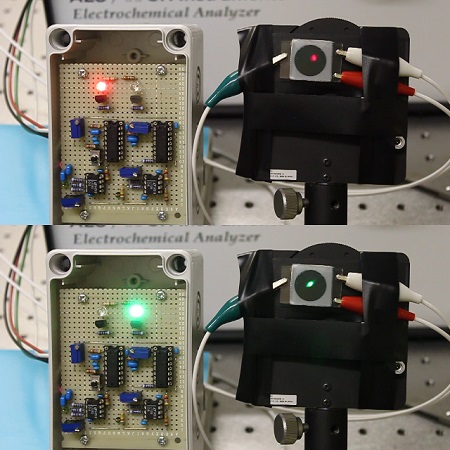局在型プラズモンと伝搬型プラズモンからの熱電子の相互作用によるユニークな光電現象の発見
Altmetric: 1More detail Article | OPEN Interplay of hot electrons from localized and propagating plasmons
2017年10月3日 Nature Communications 8 : 771 doi: 10.1038/s41467-017-00815-x

最近、プラズモン共鳴励起に基づく熱電子の生成が大きな関心を集めており、オプトエレクトロニクス、光起電力技術、グリーンケミストリーといった分野への応用を目的として研究が進められている。そのような研究は、概して、金属ナノ微粒子の局在型プラズモン、または金属膜表面の伝搬型プラズモンどちらか一方での熱電子生成によるものである。今回我々は、単一の金属-半導体デバイスにおいて、これら2種のプラズモン誘起熱電子を同時に発生させ、その熱電子生成の協同的相互作用を利用し、照射する光の波長で光電流の向きが変わる光センサーの開発に成功した。具体的には、これら2種のプラズモンがそれぞれ生成する熱電子の量と方向性のバランスによって、このデバイスに生じる正味の光電流の向きが決まるというものである。さまざまな方法で相互作用のバランスを調節することによって、可視スペクトル全域でデバイスの電流応答性と極性切り替え波長を制御することができる。この現象は、プラズモンによる熱電子生成の応用可能性を広げ、バイオセンサー、長距離通信、太陽光発電への展開が期待される。
Corresponding Authors
Plasmon-induced hot-electron generation has recently received considerable interest and has been studied to develop novel applications in optoelectronics, photovoltaics and green chemistry. Such hot electrons are typically generated from either localized plasmons in metal nanoparticles or propagating plasmons in patterned metal nanostructures. Here we simultaneously generate these heterogeneous plasmon-induced hot electrons and exploit their cooperative interplay in a single metal-semiconductor device to demonstrate, as an example, wavelength-controlled polarity-switchable photoconductivity. Specifically, the dual-plasmon device produces a net photocurrent whose polarity is determined by the balance in population and directionality between the hot electrons from localized and propagating plasmons. The current responsivity and polarity-switching wavelength of the device can be varied over the entire visible spectrum by tailoring the hot-electron interplay in various ways. This phenomenon may provide flexibility to manipulate the electrical output from light-matter interaction and offer opportunities for biosensors, long-distance communications, and photoconversion applications.

